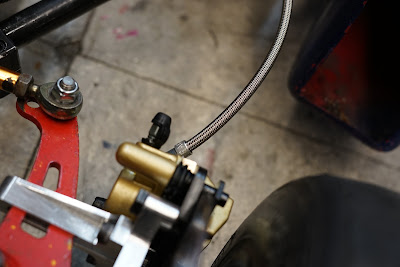Front brake conversion kits exist, but are rather expensive. Undaunted, we bought some generic moped calipers, proclaiming that "we'll figure out a way to mount them".
Ben came up with a pretty good way to mount them:
The stock direct spindle mount front wheels were replaced with a set of hub-mount rear wheels, and new hubs with 17mm bearings were made to mount them to the spindles. The arm that holds the caliper is centered using the precision-machined spindle shaft (which is the only precision surface in the kingpin assembly). Finally, a cross-piece is made which bolts to the arm and prevents it from rotating around the spindle.
Everything was made on the MITERS CNC (a mid-90's Dyna-Myte converted to LinuxCNC), and the mounts worked great.
The next step was to fill the brakes. Initial attempts were made to drive the two front calipers and the rear caliper (which had two pistons) using a single master cylinder:
 |
| Nope |
This proved to be exceedingly unsuccessful; not only did the master cylinder have borderline displacement to drive four pistons, getting the air out of the loop and matching the piston travels proved to be nearly impossible. A day and a half into the ordeal, standards were lowered, and we decided to run the front and rear brakes off separate master cylinders actuated by a single pedal.
A word on the hoses: moped calipers take banjo bolts (hollow bolts sealed with crush washers). We used Earl's Performance braided lines to turn these into -3AN flares:
The third arm of the tee is fitted with an NPT-to-compression adapter, which then goes to the master cylinder. A very unconventional setup, as compression fittings are not typically rated to brake line pressures. Go-karts get away with it with a combination of low pressures (hundreds, instead of thousands, of PSI) and short maintenance cycles (typically a couple dozen hours of runtime per season).





Do you need Emergency Water Heater & plumbing Services? Jeni's of Water Heater
ReplyDeleteIf you’re after a reliable Caliper Refurb Wolverhampton service, I’d highly recommend Alloy Refresh. I used them recently to give my calipers a full refurb and colour change, and the results were amazing. The finish looked professional, and the paint quality was excellent. Their attention to detail really stood out. It’s refreshing to find a local Wolverhampton business that delivers exactly what they promise. Alloy Refresh also kept me updated throughout, which made the experience even better. For anyone wanting their car to look sharp and well-maintained, these guys are definitely worth checking out.
ReplyDeleteTheir repipe work is flawless and dependable. Repipe Plumber
ReplyDelete